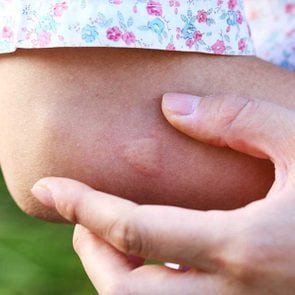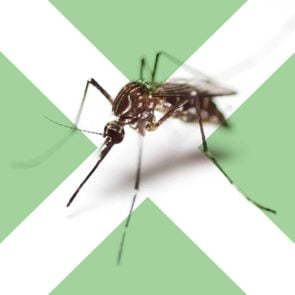Fleabites: What They Look Like and How to Prevent and Treat Them
Updated: Mar. 03, 2021
What do fleabites look like? They can itch and leave small, red bumps on your skin. Here are pictures of fleabites, as well as symptoms and ways to prevent and treat them.
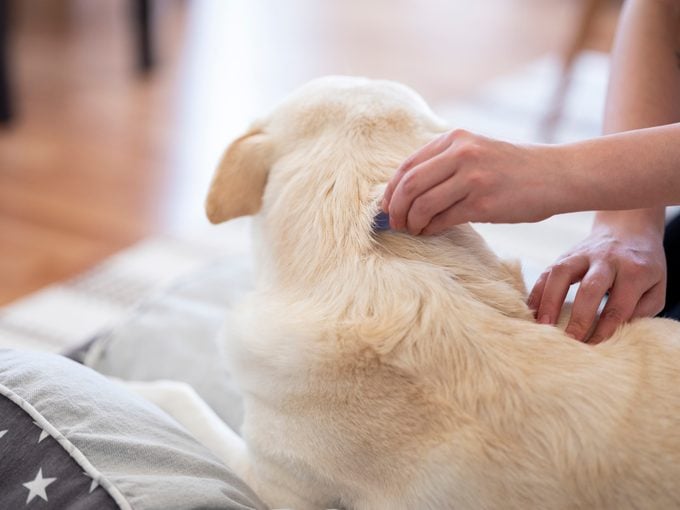 If you have a dog or cat, you’re likely familiar with the importance of checking their furry coats for fleas as well as the need for ongoing flea prevention. But your four-legged friends aren’t the only ones subject to fleas and fleabites. You are too.
If you have a dog or cat, you’re likely familiar with the importance of checking their furry coats for fleas as well as the need for ongoing flea prevention. But your four-legged friends aren’t the only ones subject to fleas and fleabites. You are too.
There are thousands of types of fleas (there are more than 2,000 species in the world and over 300 in the U.S.) that suck on the blood of animals and people. And unfortunately, every season is flea season; though fleas tend to thrive during late spring, summer, and early fall when the weather is warmer, says Meghan Feely, MD, clinical instructor, dermatology, Mount Sinai Hospital, New York City.
“In warmer climates, fleas can be present the entire year, such as in areas of the West Coast and the South,” she says. (Chiggers are also common in the summer. Here’s what a chigger bite looks like.)
If you suspect there are fleas in your home, it’s important to know what they look like, what a flea egg looks like, the symptoms, treatment, and how to prevent a fleabite. (Use this handy guide for identifying bug bites.)
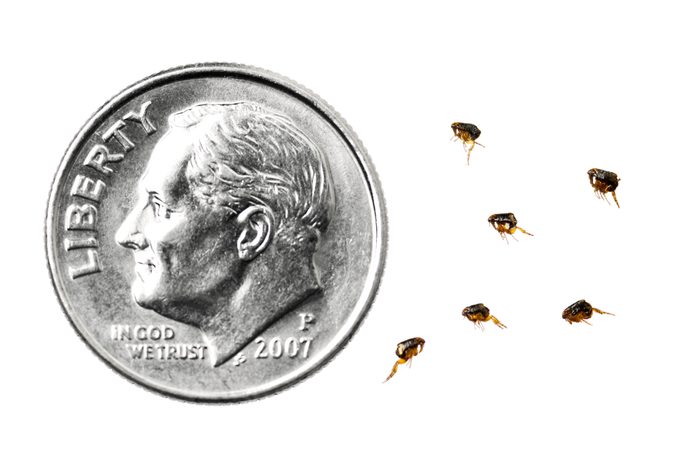 What do fleas look like?
What do fleas look like?
Fleas are parasites. Dog and cat fleas are, by far, the most common type. A flea’s life cycle comprises four stages: egg, larva (tiny worms), pupa (the life stage where they spin a silk-like cocoon and transition to adult stage), and adult.
Adult fleas are tiny—often no bigger than a pinhead. They can live about eight days on short-haired cats and dogs and longer on long-haired animals. Adult fleas are dark reddish-brown, wingless, and have three pairs of legs. Yes, three pairs of legs, which they use to jump—and jump they can. Adult fleas can jump about 8 inches. Still, fleas tend to be lazy and would rather wait for a host such as your Golden Retriever to cross their path rather than jump as far as they can to find a suitable host to munch on. And fleas are loyal little buggers. Once a flea attaches to a host, it will remain there, mate, and lay eggs for its entire life cycle or until physically removed by you, your dog’s vet, or your groomer.
Can you see flea eggs?
A female flea lays eggs within two days of her first blood meal, and produces eggs—lots of them—a few days later. The number of eggs can vary with the species and conditions, but female fleas can lay 40 to 50 eggs a day and 1,000 to 2,000 eggs in a lifetime.
These eggs and the developing eggs (maturing larvae) aren’t sticky, so they often fall off and can be found in bedding, carpeting, blankets, or around your backyard. The eggs are white or clear and can be hard to spot; about the size of a grain of sand, they can be mistaken for dandruff or dust. (Don’t overlook these surprising hazard zones in your backyard.)
“They can sit dormant for months to years, but when you come into a vacant house, the vibration sets off their hatching and within hours they biting and looking for a host,” explains Dirk Elston, MD, professor and chairman, department of dermatology and dermatologic surgery, Medical University of South Carolina, Charleston.
A flea can also survive for up to six months in the cocoon of the pupa stage, although the life cycle is usually three to six weeks under normal conditions (e.g., your home).
Where do fleas live?
Fleas aren’t all that picky when it comes to finding a host, Dr. Elston says. “The most common flea found on dogs is the cat flea. Fleas don’t care what mammal they attaching to. They will bite and infest whoever is most convenient.”
Bernard A. Cohen, MD, professor of dermatology and pediatrics, Johns Hopkins University School of Medicine, Baltimore agrees. “Fleas prefer dogs or cats, but if they need a blood meal and you are in their neighborhood, they will nibble on you before completing their lifecycle on a dog or cat,” he says. And when they bite, it can drive you to distraction, Dr. Cohen adds.
What do fleabites look like?
Fleabites are small, reddish bumps with a distinct dot in their center. These bites tend to line up in rows of three or four, Dr. Cohen explains. “We call this linear pattern, breakfast, lunch, and dinner,” he says. These bites are usually found on your legs and ankles. Flea bites tend to look like other insect bites, but if they are on your lower leg and you have a cat or dog, your doctor will likely know your bites are caused by hungry fleas, Dr. Cohen says.
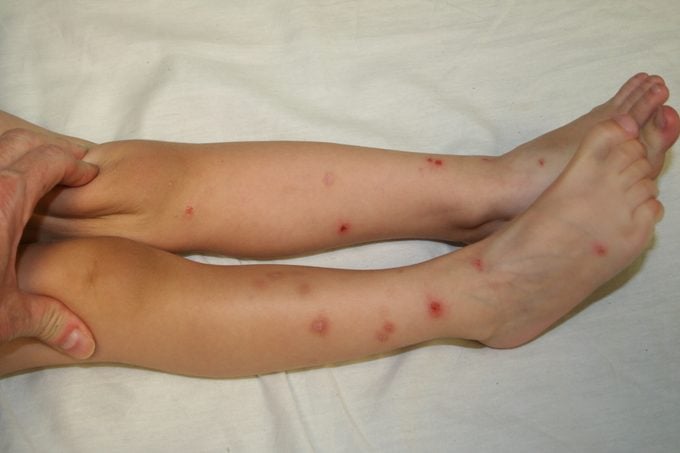
Fleabite symptoms and complications
Extreme itchiness and red, swollen bumps are likely to develop shortly after a fleabite. The site of the flea bite can become painful and can even lead to a rash or hives. “If you get bit by a flea, you will develop a nice, juicy red bump that itches like crazy,” he says.
Fleabites can also cause your pets to scratch constantly, affecting their fur coat. Most fleabites are more of a nuisance. They itch for a bit and they go away on their own. However, they can pose serious health risks if the flea is infected with a disease.
“Historically flea bites have been extremely dangerous,” Dr. Elston says. “Many of the diseases that spread through Europe started off as flea-borne including the bubonic plague and typhus fevers. The flea-borne disease is real, but in the modern world only becomes widespread during war and natural disasters.”
Fortunately, these occurrences are relatively rare in the United States, he says.
How do you treat fleabites?
Treating a fleabite depends largely on whether or not it is infected and how much it bothers you. “If the flea embeds its head into the skin, use a pair of clean tweezers and pull it from the skin,” Dr. Feely says. Sometimes topical malathion five percent, which is used to treat head lice infestations, is prescribed to treat fleas in humans, she says.
If your fleabites itch so badly that you can’t even sleep, an over-the-counter (OTC) or prescription anti-itch cream or injections of corticosteroid may help you feel more comfortable, Dr. Elston says. An OTC allergy medication can also help curb itching. (Learn more about how to treat common bug bites and stings.)
Fleabite infections
If you scratch too aggressively and there are bacteria on your nails, you can end up with a secondary infection, he says. Most are simple infections from scratching the nagging itch, and oral or topical antibiotics will do the trick, says Elton. (There are many reasons why you shouldn’t scratch a bug bite.)
How can you tell if your flea bite is infected? Look for pus, tenderness, redness, and spreading inflammation, he adds.
Another risk of flea bites mainly affects children. It is known as a fleabite-delayed hypersensitivity reaction, Dr. Cohen says. In these cases, there is no real reaction after the first flea bite, but with more exposure down the road, the child can develop itchiness that can last up to six weeks.
“If you are sensitive because you were exposed in the first couple of years of life, you will get a much more dramatic reaction.” Treating this reaction usually involves daily antihistamines to stop the itch and topical steroids on the bites. (Also, here are some mosquito bite treatments do’s and dont’s.)
How to get rid of fleas on pets and at home
If your dog or cat is infected, your veterinarian has treatments in his or her arsenal that can kill adult fleas and are safe for you and your pets. Washing your pet with soap and using a flea comb may be enough to help with minor infestations. It’s also important to make sure you get rid of any errant eggs, larvae, and pupae in the home. Vacuuming frequently removes up to 30 percent of larvae and 60 percent of eggs from the carpet. (Here’s a list of products that will help you get rid of fleas for your home and pets.)
Change bedding often, too. Contact an exterminator to make sure you get the last of them, Dr. Elston suggests. (Learn the reason why your messy house is making you sick.)
How to prevent fleabites and infestations
Prevention is the name of the game—especially if you have a pet. Use insect repellents that contain DEET 20 percent to 30 percent and wear clothing that covers exposed skin when spending time outdoors, Dr. Cohen says. (Also, here are some chemical-free bug repellants that actually work.)
Your vet can likely recommend flea prevention such a liquid or gel that is applied to your pet’s skin, pills, or specialized flea collars that stave off the infestation, he adds.



















